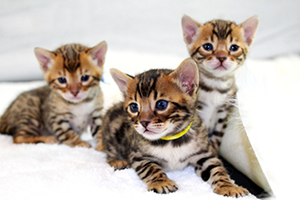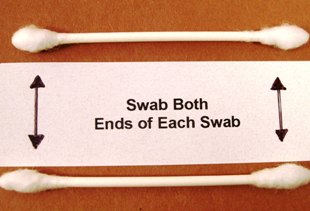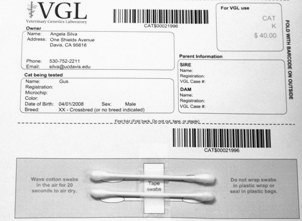Quick Summary
Click here for Price and Turnaround Time
Phenotype: Cats affected with this form of blindness have normal vision at birth, with degeneration first detected at about seven months of age. Vision loss progresses slowly and is variable, with most cats becoming blind at about 3-5 years of age.
Mode of Inheritance: Autosomal recessive
Alleles: N = Normal, rdAc = Progressive retinal atrophy (CEP290 mutation-associated)
Breeds appropriate for testing: Abyssinian, American Curl, American Wirehair, Balinese, Bengal, Colorpoint Shorthair, Cornish Rex, Devon Rex, Javanese, Manx, Munchkin, Ocicat, Oriental Longhair, Oriental Shorthair, Peterbald, Ragdoll, Savannah Cat, Siamese, Singapura, Somali, and Tonkinese. This genetic variant has also been detected in the American Shorthair, European Shorthair, Donskoy, Havana Brown, Highlander, Maine Coon, Pixie-bob, Scottish Fold, Sphynx and Tennessee Rex.
Explanation of Results:
- Cats with N/N genotype do not have CEP290/rdAc progressive retinal atrophy and cannot transmit this progressive retinal atrophy variant to their offspring.
- Cats with N/rdAc genotype do not have CEP290/rdAc progressive retinal atrophy, but are carriers. They will transmit this progressive retinal atrophy variant to 50% of their offspring. Matings between two carriers are predicted to produce 25% kittens affected by this CEP290/rdAc form of progressive retinal atrophy.
- Cats with rdAc/rdAc genotype will have CEP290/rdAc progressive retinal atrophy, an untreatable condition leading to eventual blindness. They will transmit this progressive retinal atrophy variant to all of their offspring.
$44 one test per animal
Also available as part of the following packages:
- $66 this test + PRA Rdy test OR PK Deficiency test (Abyssinian, Somali, and domestic shorthair)
- $88 this test + PRA Rdy test + PK Deficiency test (Abyssinian, Somali, and domestic shorthair)
Cat DNA tests are carried out using cells brushed from your cat's cheeks and gums using household cotton swabs.
The cat DNA submission form with instructions and a place to tape the cotton swabs is sent to you via email after you place an order, and can be printed from your home computer. DNA test kits are no longer mailed.
Instructions
Step-By-Step:
1.
 Purchase regular household cotton swabs for cat DNA collection (the cotton swabs can be purchased at a pharmacy or drug store)
Purchase regular household cotton swabs for cat DNA collection (the cotton swabs can be purchased at a pharmacy or drug store)
2.

Make sure the cat has not had anything to eat or drink for at least 1 hour prior to collecting sample.
When swabbing kittens, isolate each kitten from the mother, littermates and any shared toys for 1 hour prior to swabbing. Kittens should not have nursed or eaten for 1 hour prior to collecting sample.
If collecting samples from more than one cat, make sure to sample one cat at a time and wash your hands before swabbing another cat.
3.
 Use both ends of the two cotton swabs for a total of four swabs.
Use both ends of the two cotton swabs for a total of four swabs.
4.
Place the cotton head of the swab between the cat’s gums and cheek and rub or rotate the swab back and forth for 15 seconds. Repeat with each cotton swab head, for a total of 4 swabs. We recommend swabbing a different area of the gums with each swab head.
5.
Wave the swab in the air for 10-15 seconds to air dry it before attaching it to the submission form.
6.
 After swabbing the cheek and gums, tape the cotton swabs to the bar-coded submission form printed from your MyVGL account.
After swabbing the cheek and gums, tape the cotton swabs to the bar-coded submission form printed from your MyVGL account.
ATTENTION:
- Do not collect saliva/drool – the key to obtaining a good sample is getting cheek cells on the swab.
- Do not rub swab on the cat’s tongue or teeth – this will result in poor quality sample.
- Do not collect a sample from a kitten that has recently nursed – the mother’s genetic material can rub off on the kitten’s mouth and contaminate the sample.
In Abyssinian, Somali, and some Ocicat breeds, an inherited late-onset blindness condition has been identified and is characterized by progressive degeneration of the photoreceptors (rods and cones) in the retina. This disease has been designated "rdAc". Cats affected with this form of blindness have normal vision at birth, with degeneration first detected by electroretinographic (ERG) exam at about seven months of age. Vision loss progresses slowly and is variable, with most cats becoming blind by usually 3-5 years of age. There is no treatment available for the condition. This is an autosomal recessive condition, thus the disease is not associated with sex and two copies of the mutation are required for the cats to lose their vision. Carriers, cats that have one copy of the mutation, are not affected and have normal vision.
A single nucleotide mutation in the gene called CEP290 produces a defective protein which is associated with this progressive retinal atrophy (PRA) in the cat. In addition to Abyssinian, Somali and Ocicat, a survey of 43 cat breeds showed presence of the CEP290 mutation in many other breeds including, American Curl, American Wirehair, Bengal, Balinese/Javanese, Colorpoint Shorthair, Cornish Rex, Munchkin, Oriental Shorthair, Peterbald, Siamese, Singapura and Tonkinese. The high frequency of the CEP290 mutation in Siamese (about 33%) and related breeds (Oriental Shorthair, Balinese/Javanese, Colorpoint Shorthair, Peterbald) poses a significant health risk in the Siamese breed group.
To assist owners and breeders in identifying affected and carrier cats, the VGL offers DNA tests for the two mutations known to cause the two different forms of PRA in cats - rdAc (CEP290) and Rdy (CRX). Breeders can use these tests as tools to avoid breeding two carriers of rdAc which would produce 25% affected offspring, or to test for the presence of “Rdy” in the CRX gene of suspected affected cats.
Since both forms of blindness are found in the Abyssinian breed, all associated breeds may have a concern for these diseases. A novel form of blindness occurs in the Bengal cat, and a separate causative mutation has been identified (a genetic test for the Bengal-specific PRA is available here). However, since Bengal cats have had Abyssinian breedings in their ancestry, genetic testing for rdAc and Rdy may also be warranted in some Bengal lines.
